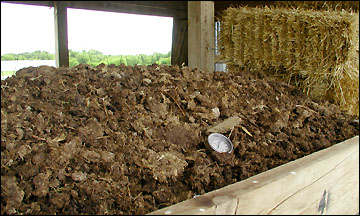Animal mortality composting is clean, inexpensive, safe
During an educational meeting last week in Eden Valley sponsored by the Minnesota Pork Producer's Board, the Stearns County Soil and Water Conservation District, and the University of Minnesota Extension Service, 45 animal producers from the area learned about animal mortality composting as a safe alternative to burying, incinerating, or rendering their animal mortalities.
Animal mortality composting - the process of burying dead animals in an above-the-ground biofilter - is viable for producers of any size and is appropriate for disposing of most animals, including cattle, hogs, sheep, turkeys, and chickens. It works much in the way that composting plant matter works, according to Roger Walker, an extension educator with the University of Minnesota Extension Service.
 The Langmo Turkey Farm near Eden Valley uses this animal mortality composting facility to dispose of dead turkeys. The compost in this bin will stay at about 150 degrees for several weeks, killing any bacteria.
The Langmo Turkey Farm near Eden Valley uses this animal mortality composting facility to dispose of dead turkeys. The compost in this bin will stay at about 150 degrees for several weeks, killing any bacteria.
Animal mortalities are placed in a compost facility with organic matter, usually wood shavings or straw. As bacteria decompose the animal, the temperature of the compost pile rises, killing any harmful bacteria or weed seeds. When the temperature falls, the process is finished. During the process, flesh and bones are turned into a soil-like substance that can be worked back into farm fields.
Animal mortality composting can be done on a small or large scale, under a roof or in the open, and is practical for producers of any size, said Walker. The USDA recommends that composting facilities have concrete floors and roofs to eliminate water run-off, but composting can also be done in open compost piles or in furrows. For a very small producer, burying a small animal (turkey, chicken, or a lamb) in a manure pile can be an effective way of turning it into compost, said Walker.
Langmo, who estimated that he loses seven to ten turkeys each day, began composting turkey mortalities because the cost of incinerating his losses was too high. As the cost of fuel and shipping the birds to an incinerator rose, Langmo began to see his profits dwindle.
Disease control is important to animal producers, and Langmo worried about having his turkey losses hauled to rendering facilities because the trucks used could spread disease.
Also, rendering is expensive, according to Steve Sellnow of the USDA's Natural Resources Conservation Service. To have a cow rendered costs between $15 and $35 per animal and the producer has the added chore and cost of keeping the carcass cool until the rendering company picks it up, sometimes several days after the animal died.
In Langmo's case, burial - the method most often used by area farmers - also wasn't practical because he worried about contaminating the watershed. An added downfall to burial was when turkeys died in the winter, they couldn't be buried until the ground thawed, which would have left him with a pile of dead turkeys at the end of each winter.
A well-planned animal mortality composting site eliminates the high cost of incinerating or rendering the animals, is much less time and labor intensive than burying animals, and aids in disease control on the farm, said Walker.
Langmo has about $7,000 invested in his compost facility, but his is large enough to hold several hundred turkeys, he said. It was also planned so as not to be an eyesore and has features that help keep the farmer comfortable while working in the facility. An EQIP grant from the USDA paid half of the costs of building Langmo's facility, and the USDA provided free technical advice and planning for the facility. The ongoing cost of using the compost facility is virtually nothing, Langmo said. Langmo does not grow straw, so he must purchase the straw that envelopes the animals during the process. Otherwise, he figures the only expense is for the time - about a half-hour a day - that his farm help spends monitoring the compost and turning the piles.
Odor is not a problem with a well-maintained animal mortality composting facility, said Walker. Wood shavings or other organic matter form a barrier that traps odors. The only time odor is a problem is when the compost is turned, usually with a skid loader, but the odor dissipates quickly after the pile has been re-covered, said Langmo.
Also, flies are not a problem, said Langmo. The temperature of the compost pile is too high for fly larvae to live.
Currently, producers do not need to have a permit (except for any necessary building permits) to start an animal mortality composting facility, although the Minnesota Board of Animal Health does require producers to register large-animal (cows, horses, etc.) facilities.
For more information on animal mortality composting or about the EQIP program, contact the Stearns County Natural Resources Con- servation Service at 320-251-7800.
Contact the author at editor@paynesvillepress.com • Return to News Menu
Home | Marketplace | Community